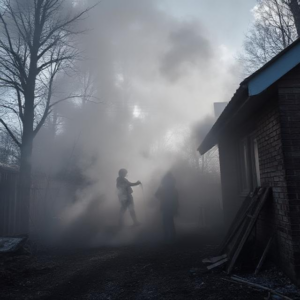
Understanding what does soot look like is crucial when recovering from a fire, as the visible damage often takes center stage while the residue it leaves behind can be equally, if not more, problematic. Soot from combustion not only structurally undermines the property but poses an equally serious health challenge to those exposed. Fire-damaged houses are a sale-by-real estate agents, but the owners must carefully consider the issue of soot in order to improve the marketability and appeal of the property. It is potentially successful in turning the difficult sale into a successful one.
What Does Soot Look Like?
Soot and mold can often be confused by homeowners as both can create dark patches on walls and other surfaces. However, soot is not moisture dependent to form, unlike mold it’s formed from incomplete combustion of materials like wood, plastic, or petroleum-based products. Soot deposits can vary depending on the type of material that burned during the fire. For example:
- Dry Soot: Created by rapidly burning high-temperature fires fueled by wood or paper, it is a powdery material that is relatively easy to clean.
- Oily Soot: Strong smoke, caused by a slow-moving burn with the aid of synthetic products, like plastics or rubber. This material is more challenging to clean, often leaving behind grease-like streaks and residue.
- Protein-Based Residue: From fires involving food or cooking oils, this soot can leave an invisible film with a strong, unpleasant odor.
Is Soot Harmful?
Soot is much more than just an eyesore! It certainly carries potential health implications for both sides and property. This is why soot is classified as harmful.
1.Potential Health Issues
Soot particles are extremely fine, often smaller than dust or pollen, and can become airborne easily. When inhaled, such particles can be delivered very deep into the lungs, resulting in respiratory issues and possibly even aggravating pre-existing diseases including asthma or bronchitis. Chronic exposure to soot has also been a contributing factor for some cardiovascular diseases and in some cases, the increased possibility of cancers according to the carbon-based compounds and heavy metals it may contain.
2. Property Damage
Soot, being acidic by nature, can cause major corrosion to various surfaces if not cleaned properly. Understanding what does soot look like is essential, as it can lead to damage on walls, ceilings, furniture, and even electronics. Porous surfaces like fabrics or drywall are particularly vulnerable, as soot tends to penetrate deeply, leaving behind stubborn stains and persistent odors. For property sellers, soot-stained surfaces present a significant challenge, potentially deterring prospective buyers and lowering the perceived value of the home.
3. Lingering Smells
Soot is often accompanied by the smell of smoke, which can linger in a home for months if not addressed. This odor can seep into carpets, upholstery, and even the structure of the house itself, making the environment feel unwelcoming and unappealing to buyers.
Dealing with Soot in Fire-Damaged Homes
To make a fire-damaged property market-ready, homeowners must understand what does soot look like and address it thoroughly. Here are actionable steps to tackle it:
1. Check the Damage
Inspect the property to determine the extent of soot accumulation. Pay special attention to HVAC systems, as soot particles can circulate through air ducts and get redistributed throughout the house.
2. Professional Cleaning
While minor soot marks may be removable with DIY methods, significant damage should be handled by professional cleaners. Experts use specialized tools like industrial vacuums, dry sponges, and chemical cleaning agents designed to remove soot without worsening the damage.
3. Deodorization
Soot-related odors are stubborn and require advanced techniques to eliminate. Ozone treatments, thermal fogging, and activated charcoal are commonly used by professionals to neutralize the smells embedded within the property.
4.Repair & Restoration
Property surfaces damaged by soot, such as discolored walls or corroded appliances, should be repaired or replaced as needed. A fresh coat of paint over treated areas can give the home a cleaner, newer appearance.
5. Improving Air Quality
Replace HVAC filters and clean out air ducts to ensure no soot particles remain in the ventilation system. Installing air purifiers can further improve indoor air quality and create a healthier living space for future occupants.
Selling Homes with Fire Damage and Soot Problems
If you’re preparing to sell a fire-damaged home, it’s essential to address soot comprehensively to maximize the property’s appeal. Here are a few tips tailored to sellers:
- Transparency Is Key: Be upfront about the fire incident and detail the steps you’ve taken to address both visible and hidden damage.
- Highlight Restoration Efforts: Buyers will appreciate knowing the home has been professionally cleaned and treated for soot and related odors.
- Invest in Staging: Once soot issues are resolved, staging the home can help potential buyers envision the space’s potential.
- Consult Specialists: If the property has extensive damage, consider working with real estate investors or companies that specialize in buying fire-damaged homes.
Soot may seem like a minor after-effect of fire damage, but its impact can be long-lasting and detrimental to both health and property value. Understanding what does soot look like is the first step in tackling the issue effectively. Removing soot and restoring your property can create a safer, healthier space and make it more appealing to buyers.
Previous